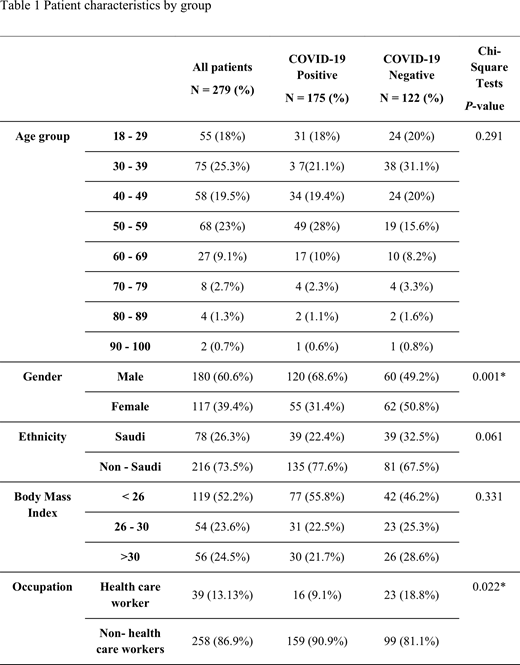Background: Coronavirus disease 2019 (COVID-19) caused by acute respiratory syndrome coronavirus 2 (SARS2), is associated with significant morbidity and mortality. The aim of this study is to characterize risk factors and clinical features of COVID-19 disease in an adult cohort in Jeddah, Saudi Arabia.
Methods: A retrospective case control study was conducted at King Abdulaziz University hospital (KAUH) in Jeddah, Saudi Arabia. Clinical and demographic data on patients presenting at KAUH with concern for COVID-19 disease between March 18 and May 18, 2020 were collected and analyzed.
Results: Electronic medical records on 297 patients presenting at KAUH were reviewed. Of these, 175 (59%) tested positive for COVID-19 by polymerase chain reaction (PCR) and 122 (41%) tested negative. COVID-19 positive patients were more likely to be males (OR=1.59; 95% CI=1.22-2.07), and non-health care workers (OR=1.53; 95% CI=1.13-2.08). Hypertension (10%), diabetes (10%), and two or more concurrent co-morbid conditions (54.4%), were more prevalent among COVID-19 positive patients. Patients presenting with fever, cough, and loss of sense of taste or smell were more likely to test positive for COVID-19 (p=0.001, 0.008, 0.008, respectively. Radiological evidence of pneumonia was associated with confirmed COVID-19 disease. Dyspnea, cough and gastrointestinal symptoms were not associated with risk of COVID-19 at presentation. On admission, white blood cells, neutrophils, lymphocytes, eosinophils, basophils, and platelets were significantly lower among COVID-19 positive patients compared to controls. Surprisingly, D-dimer levels were lower among COVID-19 positive patients. Furthermore, only two patients developed thrombosis; one with pulmonary embolism and one with coronary artery thrombosis.
Conclusion: Male gender, hypertension and diabetes were associated with risk of COVID-19 disease in this study population. D-dimer levels were not elevated in COVID-19 patients, and venous thromboembolism was not prevalent in cases, compared to controls. This is in contrast to previous reports on the association of COVID-19 disease with venous thromboembolism in other populations. Thus, individual and environmental risk factors may play an important role in the pathophysiology of thrombosis in COVID-19 disease.
No relevant conflicts of interest to declare.
Author notes
Asterisk with author names denotes non-ASH members.


This feature is available to Subscribers Only
Sign In or Create an Account Close Modal